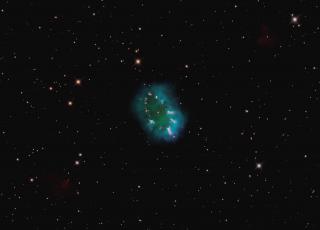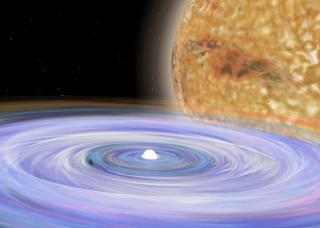Bibcode
DOI
Wesson, R.; Barlow, M. J.; Corradi, R. L. M.; Drew, J. E.; Groot, P. J.; Knigge, C.; Steeghs, D.; Gaensicke, B. T.; Napiwotzki, R.; Rodriguez-Gil, P.; Zijlstra, A. A.; Bode, M. F.; Drake, J. J.; Frew, D. J.; Gonzalez-Solares, E. A.; Greimel, R.; Irwin, M. J.; Morales-Rueda, L.; Nelemans, G.; Parker, Q. A.; Sale, S. E.; Sokoloski, J. L.; Somero, A.; Uthas, H.; Walton, N. A.; Warner, B.; Watson, C. A.; Wright, N. J.
Bibliographical reference
The Astrophysical Journal, Volume 688, Issue 1, pp. L21-L24.
Advertised on:
11
2008
Journal
Citations
77
Refereed citations
65
Description
Nova V458 Vul erupted on 2007 August 8 and reached a visual magnitude of
8.1 a few days later. Hα images obtained 6 weeks before the
outburst as part of the IPHAS Galactic plane survey reveal an 18th
magnitude progenitor surrounded by an extended nebula. Subsequent images
and spectroscopy of the nebula reveal an inner nebular knot increasing
rapidly in brightness due to flash ionization by the nova event. We
derive a distance of 13 kpc based on light travel time considerations,
which is supported by two other distance estimation methods. The nebula
has an ionized mass of 0.2 Msolar and a low expansion
velocity: this rules it out as ejecta from a previous nova eruption, and
is consistent with it being a ~14,000 year old planetary nebula,
probably the product of a prior common envelope (CE) phase of evolution
of the binary system. The large derived distance means that the mass of
the erupting WD component of the binary is high. We identify two
possible evolutionary scenarios, in at least one of which the system is
massive enough to produce a Type Ia supernova upon merging.
Related projects

Bipolar Nebulae
This project has three major objectives: 1) To determine the physico-chemical characteristics of bipolar planetary nebulae and symbiotic nebulae, to help understanding the origin of bipolarity and to test theoretical models, mainly models with binary central stars, aimed at explaining the observed morphology and kinematics. 2) To study the low
Antonio
Mampaso Recio

Binary Stars
The study of binary stars is essential to stellar astrophysics. A large number of stars form and evolve within binary systems. Therefore, their study is fundamental to understand stellar and galactic evolution. Particularly relevant is that binary systems are still the best source of precise stellar mass and radius measurements. Research lines
Pablo
Rodríguez Gil